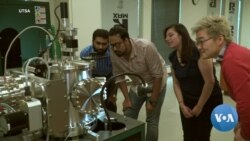ບັນດານັກຄົ້ນຄວ້າທີ່ມະຫາວິທະຍາໄລ ເທັກຊັສ ໃນເມືອງ ແຊນ ແອນໂທນີໂອ ແມ່ນ
ກຳລັງເຮັດວຽກ ກ່ຽວກັບແບັດເຕີຣີລຸ້ນໃໝ່ ສິ່ງສະໜອງໄຟຟ້າເຊິ່ງຕາມທິດສະດີແລ້ວ
ເກືອບວ່າຈະບໍ່ຕ້ອງການໃຫ້ສາກຄືນອີກເລີຍ. ນັກຂ່າວວີໂອເອ ເຄວິນ ອີນິກສ໌ ມີລາຍ
ງານ ເຊິ່ງ ພຸດທະສອນ ຈະນຳລາຍລະອຽດມາສະເໜີທ່ານໃນອັນດັບຕໍ່ໄປ.
ມັນຮູ້ສຶກດີທີ່ຈະຈິນຕະນາການໂລກ ທີ່ແບັດເຕີຣີໂທລະສັບຂອງທ່ານ ເກືອບວ່າຈະບໍ່
ຕ້ອງການສາກອີກເລີຍ.
ແຕ່ສິ່ງດັ່ງກ່າວນັ້ນອາດກາຍເປັນຄວາມຈິງ ຖ້າການທົດລອງຂອງທ່ານ ອີທານ ອານ
ຢູ່ມະຫາວິທະຍາໄລ ເທັກຊັສ ທີ່ເມືອງ ແຊນ ແອນໂທນີໂອ ຫຼື U-T-S-A ປະສົບ
ຄວາມສຳເລັດ.
ທ່ານ ອີທານ ກ່າວວ່າ “ພວກເຮົາຢາກພັດທະນາອຸປະກອນຕ່າງໆ ທີ່ສາມາດປະຕິບັດ
ການໄດ້ເກືອບວ່າໂດຍບໍ່ມີແບັດເຕີຣີ.”
ຄວາມເປັນໄປໄດ້ດັ່ງກ່າວນັ້ນ ແມ່ນອີງໃສ່ສິ່ງນ້ອຍໆສອງຢ່າງ, ເຊິ່ງແມ່ນຄາບອນ
ແຜ່ນບາງໆ ທີ່ໜາພຽງນຶ່ງອາຕອມ ເອີ້ນວ່າ ກຣາຟີນ ແລະ ເອເລັກທຣອນ, ເຊິ່ງແມ່ນ
ຊິ້ນສ່ວນຂະໜາດນ້ອຍ ທີ່ໄດ້ສະໜອງໄຟຟ້າໃຫ້ສິ່ງຂອງຕ່າງໆຂອງພວກເຮົາຜ່ານ
ໄຟຟ້າແລ້ວ.
ຍ້ອນ ເອເລັກທຣອນ ມັນປິ່ນຢ່າງບໍ່ຢຸດຈັກເທື່ອນັ້ນ, ມັນຍັງນຳພາພະລັງງານອີກຮູບ
ແບບນຶ່ງ. ບັນດານັກວິທະຍາສາດທັງຫຼາຍນີ້ ກຳລັງພະຍາຍາມທີ່ຈະຄວບຄຸມສິ່ງທີ່
ເຂົາເຈົ້າເອີ້ນວ່າ ອີເລັກໂທຣນິກປິ່ນ.
ທ່ານ ປຣາທີກ ໂກປາລາຄຣິຊນານ, ນັກສຶກສາວິສະວະກຳ ກ່າວວ່າ “ເອເລັກທຣອນ
ມີຂະໜາດນ້ອຍຫຼາຍ ແຕ່ມັນແມ່ນເຫຼັກກ້າທີ່ແຂງແຮງຫຼາຍ. ສະນັ້ນຈິນຕະນາເບິ່ງວ່າ
ເອເລັກທຣອນ ທີ່ປິ່ນເອງຢູ່ແກນຂອງມັນ, ຫຼືບໍ່ກໍຂຶ້ນ ຫຼື ລົງ.”
ປັດຈຸບັນນີ້, ບັນດານັກຄົ້ນຄວ້າສາມາດຄວບຄຸມໄດ້ພຽງແຕ່ 2 ເປີເຊັນຂອງພະລັງ
ງານປິ່ນຂອງ ເອເລັກທຣອນ ເທົ່ານັ້ນ.
ສະນັ້ນກຸ່ມນັກສຶກສາ UTSA ຈຶ່ງໄດ້ໃຊ້ເຄື່ອງປັ່ນນີ້ ເພື່ອສ້າງຕາໜ່າງ ກຣາຟີນ ເພື່ອ
ຈັບ ແລະ ເຄື່ອນຍ້າຍເອເລັກທຣອນພວກນັ້ນ ແລະ ຮວບຮວມເອົາພະລັງງານດັ່ງ
ກ່າວນັ້ນຫຼາຍຕື່ມອີກ.
ທ່ານ ເຮບິນ ຣອຍ ເຊຣຽນ, ນັກສຶກສາ ມະຫາວິທະຍາໄລ ເທັກຊັສ ໃນເມືອງ ແຊນ
ແອນໂທນີໂອ ກ່າວວ່າ “ການໃຊ້ກຣາຟີນ ແມ່ນວິທີໃໝ່ສຳລັບພະລັງງານປິ່ນ. ມັນບໍ່
ພຽງແຕ່ແມ່ນນຶ່ງ ໃນວັດຖຸຂະໜາດນ້ອຍ ທີ່ແຂງແກ່ນທີ່ສຸດເທົ່ານັ້ນ, ແຕ່ມັນຍັງແມ່ນ
ວິທີຕ່າງໆທີ່ພວກເຮົາສາມາດປ່ຽນ ຫຼື ປັບການນຳພາກະແສໄຟຟ້າ.”
ຖ້າມັນໄດ້ຜົນ, ການນຳໃຊ້ແມ່ນຈະໃຫຍ່ຫຼາຍ, ຈາກແບັດເຕີຣີທີ່ເກືອບວ່າບໍ່ຕ້ອງການ
ສາກເລີຍ ໄປຫາການຄຳນວນໜ່ວຍພະລັງງານ ທີ່ໃຊ້ການປິ່ນຂອງເອເລັກທຣອນ ຂຶ້ນ
ຫຼື ລົງ ວິທີດຽວກັບຂໍ້ມູນ “ຂະໜາດນ້ອຍ” ຖືກໃຊ້ເປັນຮາກຖານຂອງການຂຽນໂປຣ
ແກຣມທຸກໆຊະນິດ.
ທ່ານ ອີທານ ອານ ກ່າວວ່າ “ສະນັ້ນ, ຖ້າພວກເຮົາປະສົບຄວາມສຳເລັດແລ້ວ ມັນກໍ
ຈະສາມາດຂະຫຍາຍພະລັງງານທີ່ມີປະສິດທິພາບໄດ້ຫຼາຍ, ເຊິ່ງມັນຈະເປັນບາດ
ກ້າວທີ່ສຳຄັນໃນການຄຳນວນໜ່ວຍພະລັງງານ.”
ບັນດານັກຄົ້ນຄວ້າແມ່ນໄດ້ຮັບການສະໜັບສະໜູນ ໂດຍຫ້ອງການການຄົ້ນຄວ້າວິ
ທະຍາສາດຂອງກອງທັບອາກາດ ສະຫະລັດ, ເຊິ່ງຕ້ອງການແບັດເຕີຣີຕ່າງໆທີ່ສາ
ມາດປະຕິບັດງານໄດ້ໃນສະໜາມໂດຍບໍ່ຕ້ອງສາກ.
Researchers at the University of Texas at San Antonio are working on the next generation of batteries -- a power supply that could theoretically almost never need to be recharged. VOA's Kevin Enochs reports.
It's nice to imagine a world where your cell phone's batteries would almost never need charging.
But that could be a reality if Ethan Ahn's experiments at the University of Texas at San Antonio or U-T-S-A, are successful.
"We want to develop devices that can operate almost without batteries."
That potential is based on two tiny things, a thin layer of carbon - just one atom thick - called graphene, and electrons -- charged particles that already power most of our stuff through electricity.
Because electrons are constantly spinning, they also carry another form of energy. These scientists are trying to harness what they call spintronics.
"An electron is a little but very powerful magnet. So imagine an electron that spins on its own axis, either up or down."
So far, researchers have only been able to harness about two percent of an electron's spin energy.
So the UTSA team is using this sputtering machine to create a lattice of graphene to hold and move those electrons and gather a lot more of that energy.
"Using graphene is a new approach to spintronics. Not only is it one of the strongest nanomaterials out there, but there are ways we can change or modulate its electro-conductivity."
If it works, the applications are huge, from batteries that almost never need recharging to quantum computing that uses the up or down spin of electrons the same way 'bits' of information are used as the foundation of all programming.
"So, if we are successful then it can increase energy efficiency a lot, which is going to be a very important step for quantum computing."
The researchers are being supported by the U.S. Air Force Office of Scientific Research, which needs batteries that can operate in the field without recharging.





